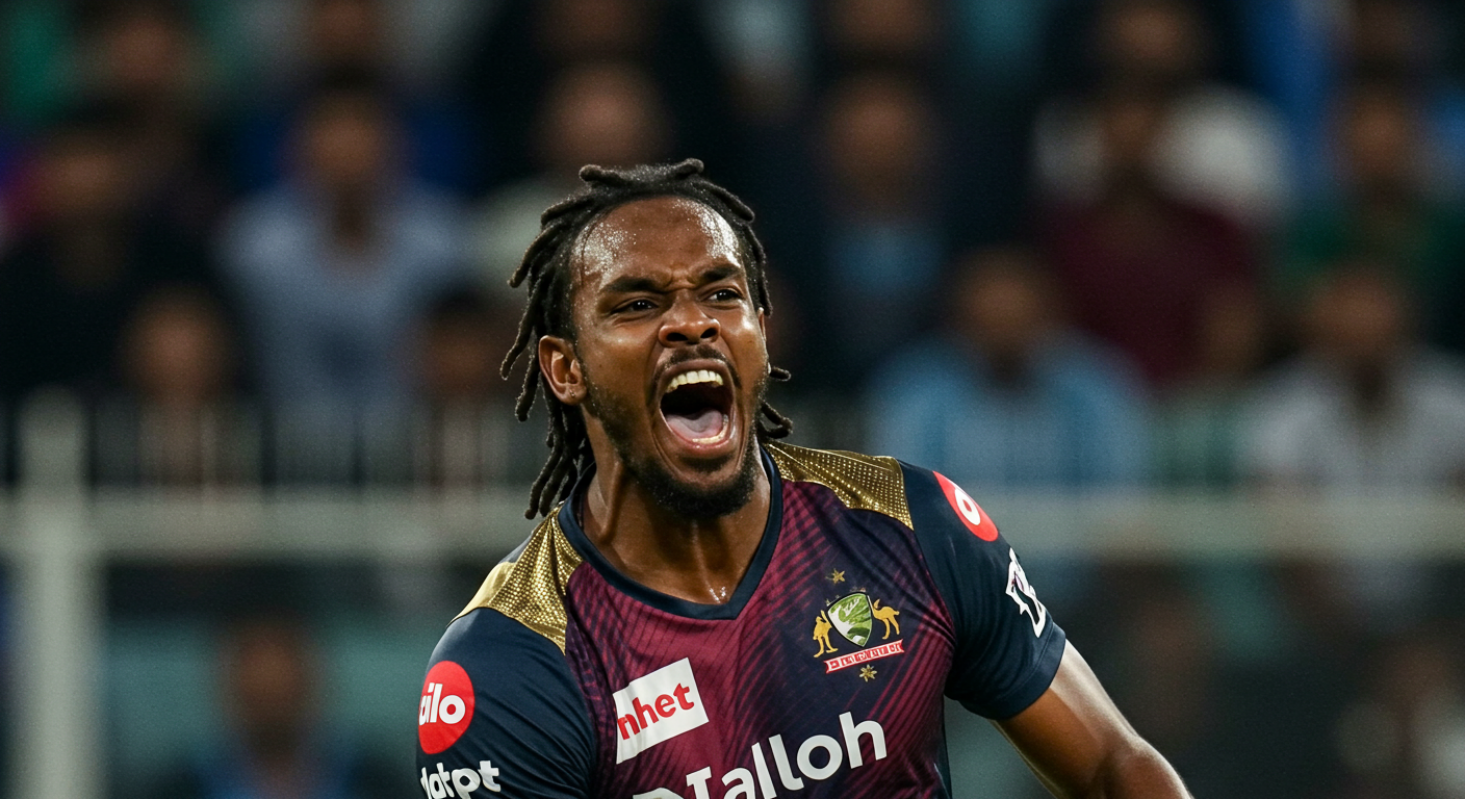
Jofra Archer: England’s Pace Phenomenon and the Battle to Stay Fit
Few players in recent memory have arrived in international cricket with the impact of Jofra Archer. From the moment he debuted for England in 2019, he brought something different — pace above 90mph, control under pressure, and a composure that belied his experience.
Archer was never just quick. He was clinical. He bowled smart spells in the powerplay, hostile short balls in the middle overs, and ice-cold yorkers at the death. His performance in the 2019 World Cup — particularly his Super Over in the final — instantly cemented his place in England’s white-ball legacy.
But alongside the rise came a recurring theme: injury. Elbow stress fractures, back trouble, multiple surgeries — Archer’s body has struggled to keep up with his extraordinary talent. What could have been a 50-Test career is still stuck in the teens. What should have been a three-format era has become a long cycle of bursts and breakdowns.
This article looks at how Jofra Archer redefined England’s pace attack — and why the battle now is less about skill and more about staying on the park.
2019: The Breakout Year That Changed Everything

Jofra Archer’s qualification for England was fast-tracked ahead of the 2019 World Cup. The selectors knew what they were doing. Archer wasn’t just an option — he was a necessity for a team chasing world domination.
In that tournament, he delivered 20 wickets at an economy under 5. More than that, he provided breakthroughs when England most needed them. He bowled fast without being erratic. His short-ball threat was real, and his yorkers were often unplayable. He adapted quickly to pressure situations, including the nerve-shredding Super Over in the final at Lord’s.
Archer’s impact wasn’t just statistical. It was strategic. He allowed England to bowl attacking lines with confidence. With him in the side, field placements were more aggressive, and game plans more flexible.
Later that summer, Archer made his Test debut in the Ashes. At Lord’s, he produced one of the most menacing spells in recent history — a 92mph barrage that concussed Steve Smith and altered the series’ tone.
That year, Archer didn’t just emerge. He exploded. And England — who had searched for raw pace for years — finally had a weapon that could compete with the best.
Injuries and the Stop-Start Nature of a Rare Career
After his explosive debut year, Jofra Archer’s progress stalled — not due to form, but fitness. A series of elbow stress fractures began a pattern of short-lived comebacks and long recovery spells. From 2020 onwards, his appearances became sporadic across formats.
He underwent multiple procedures on the elbow, missing major Test series and white-ball tournaments. Just as he seemed close to full recovery, a stress fracture in his back further derailed his return in 2022. For a fast bowler whose greatest asset is speed, these injuries weren’t just physical — they threatened his core identity.
What made it more frustrating was that whenever Archer returned, even briefly, his quality remained undeniable. In domestic T20s and warm-up games, he continued to hit speeds above 90mph with rhythm and bounce. But the gaps between appearances grew longer, and confidence in his long-term availability started to erode.
Archer has since spoken openly about the mental toll. The frustration of constant rehab, the loneliness of watching from the sidelines, and the uncertainty of whether his body will ever allow sustained Test cricket again.
For England, Archer remains a central figure in white-ball planning. But in red-ball cricket, the dream of a long Test career now feels uncertain — not because of talent, but because of time lost to injury.
Short Formats: White-Ball Specialist or Future Finisher?

Injuries may have curtailed his Test ambitions, but Archer remains a force in limited-overs cricket. His control, variation, and calm under pressure make him ideally suited for ODIs and T20Is — formats where his short bursts of pace have maximum impact.
In T20s, his economy rate hovers below 8 despite often bowling in powerplay and death overs. He uses slower balls, hard lengths, and the occasional yorker with precision. He doesn’t rely solely on express pace — he thinks through overs, sets traps, and builds pressure.
England continue to manage him carefully in white-ball cricket. His appearances are limited, but his value is undeniable — especially in knockout matches. When fit, Archer isn’t just a squad player — he’s the one bowling the 20th over, or opening against the best batters.
In franchise leagues, his presence commands top dollar. The IPL, in particular, has invested heavily in him, even during rehab phases — a clear sign of belief in his match-winning ability.
The key going forward is workload. Archer may never bowl 30 overs in a Test again, but if managed wisely, he can still deliver match-defining spells in the formats that reward precision over volume.
England’s Long-Term Strategy: Patience and Protection
The ECB knows what it has in Jofra Archer: a rare asset. Few bowlers in world cricket combine pace, accuracy, and temperament as effectively as he does. But that comes with risk — and England have had to rethink how to use him.
Rather than rushing him back for every series, England have adopted a longer-term view. He’s being managed through medical supervision, limited workloads, and extended rest periods. The priority is no longer all-format participation. It’s targeted involvement in key white-ball tournaments — World Cups, T20 World Cups, and possibly The Ashes if his body allows.
Archer has been kept on central contracts, travelled with squads even when not playing, and been included in long-term plans despite frequent setbacks. That shows commitment from the ECB, not just to his ability, but to his recovery.
They see him not just as a bowler, but as a game-changer. His value isn’t in how often he plays — it’s in how big the moment is when he does.
The goal now is clarity: limit his overs, avoid overexposure in domestic cricket, and peak for global tournaments. It’s a compromise — but one that could keep Jofra Archer relevant for another five years.
Psychological Battle: Isolation, Pressure, and Public Expectation

Injuries aren’t just physical — they affect rhythm, confidence, and mindset. For Jofra Archer, the psychological strain of repeat setbacks has been significant. The public saw a superstar in 2019. But since then, he’s spent more time in rehab than on the pitch.
Archer has admitted to feeling isolated during long recovery periods, especially during the pandemic. Cricket moved on, teams evolved, and new bowlers emerged. Yet expectations around him remained high, as if he could return and instantly pick up where he left off.
He’s also dealt with criticism. Questions about commitment, fitness discipline, and his decision to play franchise cricket while skipping Test tours have followed him. But the truth is simpler — his body hasn’t allowed consistent workloads, and England have given him the freedom to manage his own path.
Through it all, Archer has remained committed. He’s stayed visible, trained relentlessly, and avoided public outbursts. His mindset now seems clearer: play when fit, deliver when called upon, and silence doubts through performance — not explanation.
The real battle has never been about talent. It’s been about availability. And mentally, Archer’s resilience is what’s kept his international future alive despite years of disruption.
The Franchise Factor: Managing Career vs Country
Jofra Archer’s value in T20 franchise cricket is unquestionable. Even with limited fitness windows, teams are willing to invest in his potential. The IPL, The Hundred, SA20 — all have shown interest in securing Archer for short tournaments where he can impact a handful of games.
This raises an inevitable debate: should he prioritise England or his long-term earning potential through leagues? So far, Archer has tried to balance both. The ECB has supported his choices, often integrating franchise cricket into his return-to-play plans.
The franchise format suits him — short bursts, clear recovery time, fewer overs. It also allows Archer to build rhythm without the demands of back-to-back five-day matches. But every missed England tour adds pressure. The public expects national loyalty, especially after such an impactful 2019.
Still, Archer’s situation is unique. He’s not skipping matches for profit — he’s protecting his career. Franchise cricket may offer both stability and a platform to build towards England returns. The key is workload alignment, not opposition.
Handled correctly, he can still contribute to England’s white-ball success — while remaining one of the world’s most sought-after T20 specialists.
What England Lose When Archer Isn’t Available
Jofra Archer’s absence isn’t just about pace — it changes the entire team dynamic. Without him, England lose their only true enforcer with the ball. Mark Wood offers raw pace, but Archer brings variation, control, and the ability to close matches at both ends of an innings.
In white-ball cricket, especially, Archer’s overs bring flexibility. He can bowl in the powerplay, handle middle-over rebuilds, and dominate the death. No other England bowler offers that complete profile with the same level of composure and accuracy.
In Tests, Archer was England’s answer to hostile conditions — someone who could bowl with venom on flat tracks and rattle batters with sustained spells. When unavailable, England’s attack feels incomplete, lacking bite in conditions that don’t favour swing or seam.
More than the numbers, it’s the tone he sets. Archer brings presence. He forces batters to think, to rush, and to adjust. Without him, England’s edge — particularly in global tournaments — softens.
For a team that relies on match-winners, Archer’s absence remains one of its biggest gaps.
Conclusion: Jofra Archer’s Battle Is Bigger Than Form
Jofra Archer doesn’t need to prove his skill — he already has. What he’s fighting now is something far tougher: time, injury, and the fragility of potential. He was never meant to be just another quick bowler. He was meant to redefine England’s fast bowling identity for a generation.
But the body hasn’t cooperated. The pace is still there. The control still exists. What’s missing is consistency — of appearances, not quality. In any other era, Archer would be judged on wickets. Instead, he’s judged on availability.
What makes him exceptional is that even after years of injury, England still want him in every squad. That tells you how rare he is. And how worth the wait he still is.
Archer’s comeback doesn’t need to be all-format. It just needs to be managed. His presence in World Cups, Ashes series, and T20 finals can still shape outcomes. But he must be preserved, not pushed.
His career won’t be defined by longevity — but by moments. And few in world cricket deliver moments like Jofra Archer. The pace phenomenon still has time — if his body gives him the chance.





